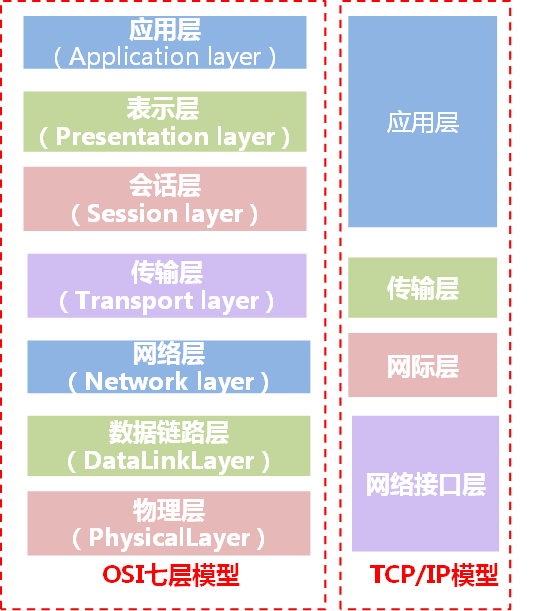网络编程
1.1 概述
网络编程从大的方面就是说对信息的发送接收。
通过操作相应API调度计算机资源硬件,并且利用管道(网线)进行数据交互的过程。
更为具体的涉及:网络模型、套接字、数据包
1.2 网络通信的要素
如何实现网络通信?
通信双方地址
1 ip
2 端口号
规则:网络通信的协议
TCP/IP参考模型

1.3 ip
作用:
1 唯一定位一台网络计算机
2 127.0.0.1:本机localhost
3 ip地址的分类:
ipv4/ipv6
公网(互联网)- 私网(局域网)
4 域名:记忆IP问题
package com.guo.Lesson01; import java.net.InetAddress; import java.net.UnknownHostException; public class TestInetAddress { public static void main(String[] args) { try { InetAddress[] InetAddress1 = InetAddress.getAllByName("127.0.0.1"); System.out.println(InetAddress1); InetAddress InetAddress2 = InetAddress.getLocalHost(); System.out.println(InetAddress2); } catch (UnknownHostException e) { e.printStackTrace(); } } }
1.4 端口
端口表示计算机上一个程序的进程;
不同的进程有不同的端口号,端口号不能冲突!用来区分软件
正常端口号:0~65535
TCP,UDP:单个协议下的端口不能冲突
公有端口:0~1023
HTTP:80
HTTPS:443
程序注册端口:1024~49151,分配给用户或程序
tomcat:8080
MySql:3306
Oracle:1521
动态,私有端口:49151~65532
netstart -ano #查看所有端口
1.5 通信协议
TCP:用户传输协议
UDP:用户数据报协议
IP:网络互联协议
1.6 TCP
客户端
1 连接服务器Socket
2 发送消息
package com.guo.Lesson02; import java.io.IOException; import java.io.OutputStream; import java.net.InetAddress; import java.net.Socket; import java.net.UnknownHostException; import java.nio.charset.StandardCharsets; //客户端 public class TcpClientDemo01 { public static void main(String[] args) { Socket socket = null; OutputStream os = null; try { //连接服务器地址:端口 InetAddress[] inetAddress = InetAddress.getAllByName("127.0.0.1"); int port = 9999; //创建Socket连接 socket = new Socket(inetAddress[0],port); os = socket.getOutputStream(); os.write("你好,欢迎学习JAVA".getBytes(StandardCharsets.UTF_8)); } catch (Exception e) { e.printStackTrace(); }finally { if (os != null){ try { os.close(); } catch (IOException e) { e.printStackTrace(); } } if (socket != null){ try { socket.close(); } catch (IOException e) { e.printStackTrace(); } } } } }
服务器
1 建立服务的端口 SeverSocket
2 等待用户连接 accept
3 接收消息
package com.guo.Lesson02; import java.io.ByteArrayOutputStream; import java.io.IOException; import java.io.InputStream; import java.net.ServerSocket; import java.net.Socket; //服务器 public class TcpServerDemo01 { public static void main(String[] args) { ServerSocket serversocket = null; Socket socket = null; ByteArrayOutputStream baos = null; InputStream is = null ; try { //创建地址端口 serversocket = new ServerSocket(9999); socket = new Socket(); //等待客户端连接 socket = serversocket.accept(); //读取客户端数据 管道流 is = socket.getInputStream(); baos = new ByteArrayOutputStream(); byte[] buffer = new byte[1024]; int len; while ((len = is.read(buffer))!=-1){ baos.write(buffer,0,len); } System.out.println(baos.toString()); } catch (IOException e) { e.printStackTrace(); }finally { if (baos != null){ try { baos.close(); } catch (IOException e) { e.printStackTrace(); } } if (is != null){ try { is.close(); } catch (IOException e) { e.printStackTrace(); } } if (socket != null){ try { socket.close(); } catch (IOException e) { e.printStackTrace(); } } if (serversocket != null){ try { serversocket.close(); } catch (IOException e) { e.printStackTrace(); } } } } }
1.7 udp
发送端
package com.guo.Lesson03; import java.net.DatagramPacket; import java.net.DatagramSocket; import java.net.InetAddress; import java.nio.charset.StandardCharsets; //不需要连接服务器 public class UdpClientDemo01 { public static void main(String[] args) { //1 建立一个socket DatagramSocket socket = null; //2 建个包 String msg = "你好啊,服务器!"; //发送对象 InetAddress[] localhost = null; try { socket = new DatagramSocket(); localhost = InetAddress.getAllByName("localhost"); int port = 9090; DatagramPacket packet = new DatagramPacket(msg.getBytes(StandardCharsets.UTF_8),0,msg.getBytes().length,localhost[0],port); //3 发送包 socket.send(packet); //4 关闭流 socket.close(); } catch (Exception e) { e.printStackTrace(); } } }
接收端
package com.guo.Lesson03; import java.net.DatagramPacket; import java.net.DatagramSocket; import java.net.SocketException; //还要等待客户端的连接 public class UdpServerDemo01 { public static void main(String[] args) { //1 开放端口 DatagramSocket socket = null; try { socket = new DatagramSocket(9090); //接收数据包 byte[] buffer = new byte[1024]; DatagramPacket packet = new DatagramPacket(buffer,0,buffer.length); //接收 socket.receive(packet); System.out.println(new String(packet.getData(),0,packet.getLength())); //关闭连接 socket.close(); } catch (Exception e) { e.printStackTrace(); } } }
循环接收消息
package com.guo.Chat; import java.io.BufferedReader; import java.io.InputStreamReader; import java.net.DatagramPacket; import java.net.DatagramSocket; import java.net.InetSocketAddress; public class UapSenderDemo01 { public static void main(String[] args) throws Exception { DatagramSocket socket = new DatagramSocket(8888); BufferedReader reader = null ; while (true){ //准备数据,从控制台读取数据System.in reader = new BufferedReader(new InputStreamReader(System.in)); String date = reader.readLine(); byte[] sendate = date.getBytes(); //需要转化为字节才能传递 DatagramPacket packet = new DatagramPacket(sendate,0,sendate.length,new InetSocketAddress("localhost",6666)); socket.send(packet); if(date.equals("bye")){ break; } } socket.close(); } }
package com.guo.Chat; import java.io.BufferedReader; import java.io.InputStreamReader; import java.net.DatagramPacket; import java.net.DatagramSocket; public class UapReceiveDemo01 { public static void main(String[] args) throws Exception { DatagramSocket socket = new DatagramSocket(6666); while(true){ byte[] container = new byte[1024]; DatagramPacket packet = new DatagramPacket(container,0,container.length); //阻塞式接收消息 socket.receive(packet); byte[] date = packet.getData(); String receiveData = new String(date,0,date.length); String newData = new String(packet.getData(),0,packet.getLength()); System.out.println(receiveData); //断开连接,跳出循环 if (receiveData.equals("bye")){ break; } } socket.close(); } }
在线咨询:
package com.guo.Talk; import java.io.BufferedReader; import java.io.IOException; import java.io.InputStreamReader; import java.net.DatagramPacket; import java.net.DatagramSocket; import java.net.InetSocketAddress; import java.net.SocketException; public class Sender implements Runnable{ DatagramSocket socket = null; BufferedReader reader = null ; private int FromPort ; private String ToIp; private int ToPort; //构造函数,开启端口,监测输入信息 public Sender(int FromPort,String ToIp,int ToPort){ this.FromPort = FromPort; this.ToIp = ToIp; this.ToPort = ToPort; try { socket = new DatagramSocket(FromPort); reader = new BufferedReader(new InputStreamReader(System.in)); } catch (SocketException e) { e.printStackTrace(); } } @Override public void run() { while (true){ try { //准备数据,从控制台读取数据System.in reader = new BufferedReader(new InputStreamReader(System.in)); String date = null; date = reader.readLine(); byte[] sendate = date.getBytes(); //需要转化为字节才能传递 DatagramPacket packet = new DatagramPacket(sendate,0,sendate.length,new InetSocketAddress(this.ToIp,this.ToPort)); socket.send(packet); if(date.equals("bye")){ break; } } catch (IOException e) { e.printStackTrace(); } } socket.close(); } }
package com.guo.Talk; import java.net.DatagramPacket; import java.net.DatagramSocket; import java.net.SocketException; public class Receiver implements Runnable { DatagramSocket socket = null ; byte[] container = new byte[1024]; private int Port; private String name; public Receiver (int Port,String name){ this.Port = Port; this.name = name; try { socket = new DatagramSocket(Port); } catch (SocketException e) { e.printStackTrace(); } } @Override public void run() { while(true){ try { DatagramPacket packet = new DatagramPacket(container,0,container.length); //阻塞式接收消息 socket.receive(packet); byte[] date = packet.getData(); String receiveData = new String(date,0,date.length); String newData = new String(packet.getData(),0,packet.getLength()); System.out.println(name+":"+newData); //断开连接,跳出循环 if (newData.equals("bye")){ break; } } catch (Exception e) { e.printStackTrace(); } } socket.close(); } }
package com.guo.Talk; public class Student { public static void main(String[] args) { new Thread(new Sender(5555,"localhost",6666)).start(); new Thread(new Receiver(7777,"老师")).start(); } }
package com.guo.Talk; public class Teacher { public static void main(String[] args) { new Thread(new Sender(8888,"localhost",7777)).start(); new Thread(new Receiver(6666,"学生")).start(); } }
1.7 URL
统一资源定位符:定位互联网的某一个资源
DNS 域名解析
1 协议://ip地址:端口/项目名/资源






 浙公网安备 33010602011771号
浙公网安备 33010602011771号